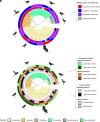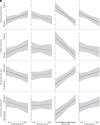The evolution of sex roles: The importance of ecology and social environment
- PMID: 38771872
- PMCID: PMC11145285
- DOI: 10.1073/pnas.2321294121
The evolution of sex roles: The importance of ecology and social environment
Abstract
Males and females often have different roles in reproduction, although the origin of these differences has remained controversial. Explaining the enigmatic reversed sex roles where males sacrifice their mating potential and provide full parental care is a particularly long-standing challenge in evolutionary biology. While most studies focused on ecological factors as the drivers of sex roles, recent research highlights the significance of social factors such as the adult sex ratio. To disentangle these propositions, here, we investigate the additive and interactive effects of several ecological and social factors on sex role variation using shorebirds (sandpipers, plovers, and allies) as model organisms that provide the full spectrum of sex role variation including some of the best-known examples of sex-role reversal. Our results consistently show that social factors play a prominent role in driving sex roles. Importantly, we show that reversed sex roles are associated with both male-skewed adult sex ratios and high breeding densities. Furthermore, phylogenetic path analyses provide general support for sex ratios driving sex role variations rather than being a consequence of sex roles. Together, these important results open future research directions by showing that different mating opportunities of males and females play a major role in generating the evolutionary diversity of sex roles, mating system, and parental care.
Keywords: adult sex ratio; habitat productivity; mating system; parental care; sex-role reversal.
Conflict of interest statement
Competing interests statement:The authors declare no competing interest.
Figures




Similar articles
-
The evolution of sex roles in birds is related to adult sex ratio.Nat Commun. 2013;4:1587. doi: 10.1038/ncomms2600. Nat Commun. 2013. PMID: 23481395
-
Sex roles in birds: Phylogenetic analyses of the influence of climate, life histories and social environment.Ecol Lett. 2022 Mar;25(3):647-660. doi: 10.1111/ele.13938. Ecol Lett. 2022. PMID: 35199926
-
Sex differences in parental care: Gametic investment, sexual selection, and social environment.Evolution. 2015 Nov;69(11):2862-75. doi: 10.1111/evo.12786. Epub 2015 Oct 13. Evolution. 2015. PMID: 26420758
-
Sex roles and sex ratios in animals.Biol Rev Camb Philos Soc. 2023 Apr;98(2):462-480. doi: 10.1111/brv.12915. Epub 2022 Oct 28. Biol Rev Camb Philos Soc. 2023. PMID: 36307924 Review.
-
Adult sex ratio variation: implications for breeding system evolution.J Evol Biol. 2014 Aug;27(8):1500-12. doi: 10.1111/jeb.12415. Epub 2014 May 22. J Evol Biol. 2014. PMID: 24848871 Review.
Cited by
-
Anisogamy and sex roles: a commentary.Evol Lett. 2024 Oct 23;8(6):761-763. doi: 10.1093/evlett/qrae058. eCollection 2024 Dec. Evol Lett. 2024. PMID: 39677570 Free PMC article.
References
-
- Davies N. B., Krebs J. R., West S. A., An Introduction to Behavioural Ecology (Wiley-Blackwell, ed. 4, 2013).
-
- Alcock J., Animal Behavior: An Evolutionary Approach (Sinauer Associates, Inc, ed. 10, 2013).
-
- Székely T., et al. , The causes and implications of sex role diversity in shorebird breeding systems. Ibis 166, 357–385 (2023) 10.1111/ibi.13277. - DOI
-
- Herridge E. J., Murray R. L., Gwynne D. T., Bussière L. F., Mating and parental sex roles, diversity. Encycl. Evol. Biol. 2, 453–458 (2016).
MeSH terms
Grants and funding
- KH130430/Nemzeti Kutatási Fejlesztési és Innovációs Hivatal (NKFI)
- PD134414/Nemzeti Kutatási Fejlesztési és Innovációs Hivatal (NKFI)
- ANN143995/Nemzeti Kutatási Fejlesztési és Innovációs Hivatal (NKFI)
- ÉLVONAL KKP-126949/Nemzeti Kutatási Fejlesztési és Innovációs Hivatal (NKFI)
- K-116310/Nemzeti Kutatási Fejlesztési és Innovációs Hivatal (NKFI)
LinkOut - more resources
Full Text Sources

